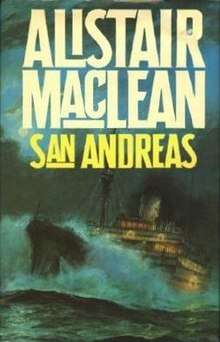San Andreas (novel)
 First edition (UK) | |
| Author | Alistair MacLean |
|---|---|
| Country | United Kingdom |
| Language | English |
| Publisher |
Collins (UK) Doubleday (US) |
Publication date | 1984 |
| Media type | Hardcover Print |
| Pages | 306 pp. |
| ISBN | 0-385-23152-0 |
| OCLC | 11784511 |
| 823/.914 19 | |
| LC Class | PR6063.A248 S2 1985 |
| Preceded by | Floodgate |
| Followed by | Santorini |
San Andreas is a novel by Scottish author Alistair MacLean, first published in 1984. One of his final novels, it returns to MacLean's original (and most successful) genre: war at sea.
Plot introduction
The British Merchant Navy hospital ship San Andreas is en route from Murmansk to Halifax, Nova Scotia during World War II. It is forced to change its destination to Aberdeen, Scotland. It belonged to the Liberty Ship class design with large red crosses painted on the sides of its hull, San Andreas should have immunity from attack from all sides in the war and be granted safe passage. The first sign of trouble occurs when the ship's lights mysteriously fail just before a pre-dawn bombing attack that severely damages its superstructure and sinks its escort frigate. With most of the senior officers dead and the captain incapacitated, Bosun Archie McKinnon must take charge of the damaged ship and steer her to safety despite German aircraft, U-boats, stormy Arctic weather and sabotage by an unknown traitor on board. He must also discover the reason for the frantic and repeated German attempts to sink the San Andreas.
Notes
A Sikh crew-member of the San Andreas claims initially to be "from Pakistan" but is revealed later to be an anti-Imperialist from India. The nation of Pakistan did not exist until 1947, two years after World War II (the timeframe for the novel) ended, although the name "Pakistan" was used to describe the Northwestern area of British India from the mid-1930s onward.
There are also references to Fritz-Julius Lemp as the man who sank the SS Athenia, stated by one of the crew as an example of the limited protection the San Andreas had under the Geneva Convention as a Hospital Ship. However, although Allied suspicion was always on a U-Boat sinking the Athenia it was not confirmed until after the war at the Nuremberg Trials.
".. he's blowing all main ballast. See those bubbles? That’s water being blown from the ballast tanks by high pressure air - something like three thousand pounds per square inch." is a very strange way to do a crash dive. Maclean confuses blowing the tanks for an emergency surface with flooding them to go down. He repeats the error with a second sub diving later on.[1]